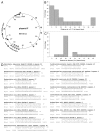CRISPR-Cas systems preferentially target the leading regions of MOBF conjugative plasmids
- PMID: 23535265
- PMCID: PMC3737333
- DOI: 10.4161/rna.24202
CRISPR-Cas systems preferentially target the leading regions of MOBF conjugative plasmids
Abstract
Most prokaryotes contain CRISPR-Cas immune systems that provide protection against mobile genetic elements. We have focused on the ability of CRISPR-Cas to block plasmid conjugation, and analyzed the position of target sequences (protospacers) on conjugative plasmids. The analysis reveals that protospacers are non-uniformly distributed over plasmid regions in a pattern that is determined by the plasmid's mobilization type (MOB). While MOBP plasmids are most frequently targeted in the region entering the recipient cell last (lagging region), MOBF plasmids are mostly targeted in the region entering the recipient cell first (leading region). To explain this protospacer distribution bias, we propose two mutually non-exclusive hypotheses: (1) spacers are acquired more frequently from either the leading or lagging region depending on the MOB type (2) CRISPR-interference is more efficient when spacers target these preferred regions. To test the latter hypothesis, we analyzed Type I-E CRISPR-interference against MOBF prototype plasmid F in Escherichia coli. Our results show that plasmid conjugation is effectively inhibited, but the level of immunity is not affected by targeting the plasmid in the leading or lagging region. Moreover, CRISPR-immunity levels do not depend on whether the incoming single-stranded plasmid DNA, or the DNA strand synthesized in the recipient is targeted. Our findings indicate that single-stranded DNA may not be a target for Type I-E CRISPR-Cas systems, and suggest that the protospacer distribution bias might be due to spacer acquisition preferences.
Keywords: CRISPR; adaptive immunity; conjugation; mobile genetic element; plasmid mobilization; protospacer distribution.
Figures




Similar articles
-
CRISPR-spacer integration reporter plasmids reveal distinct genuine acquisition specificities among CRISPR-Cas I-E variants of Escherichia coli.RNA Biol. 2013 May;10(5):792-802. doi: 10.4161/rna.24023. Epub 2013 Feb 27. RNA Biol. 2013. PMID: 23445770 Free PMC article.
-
Degenerate target sites mediate rapid primed CRISPR adaptation.Proc Natl Acad Sci U S A. 2014 Apr 22;111(16):E1629-38. doi: 10.1073/pnas.1400071111. Epub 2014 Apr 7. Proc Natl Acad Sci U S A. 2014. PMID: 24711427 Free PMC article.
-
Priming in the Type I-F CRISPR-Cas system triggers strand-independent spacer acquisition, bi-directionally from the primed protospacer.Nucleic Acids Res. 2014 Jul;42(13):8516-26. doi: 10.1093/nar/gku527. Epub 2014 Jul 2. Nucleic Acids Res. 2014. PMID: 24990370 Free PMC article.
-
CRISPR-Cas adaptation in Escherichia coli.Biosci Rep. 2023 Mar 31;43(3):BSR20221198. doi: 10.1042/BSR20221198. Biosci Rep. 2023. PMID: 36809461 Free PMC article. Review.
-
SMV1 virus-induced CRISPR spacer acquisition from the conjugative plasmid pMGB1 in Sulfolobus solfataricus P2.Biochem Soc Trans. 2013 Dec;41(6):1449-58. doi: 10.1042/BST20130196. Biochem Soc Trans. 2013. PMID: 24256236 Free PMC article. Review.
Cited by
-
Efficient inter-species conjugative transfer of a CRISPR nuclease for targeted bacterial killing.Nat Commun. 2019 Oct 4;10(1):4544. doi: 10.1038/s41467-019-12448-3. Nat Commun. 2019. PMID: 31586051 Free PMC article.
-
The role of CRISPR-Cas systems in virulence of pathogenic bacteria.Microbiol Mol Biol Rev. 2014 Mar;78(1):74-88. doi: 10.1128/MMBR.00039-13. Microbiol Mol Biol Rev. 2014. PMID: 24600041 Free PMC article. Review.
-
Special focus CRISPR-Cas.RNA Biol. 2013 May;10(5):655-8. doi: 10.4161/rna.24687. RNA Biol. 2013. PMID: 23872677 Free PMC article. No abstract available.
-
Digging into the lesser-known aspects of CRISPR biology.Int Microbiol. 2021 Nov;24(4):473-498. doi: 10.1007/s10123-021-00208-7. Epub 2021 Sep 6. Int Microbiol. 2021. PMID: 34487299 Free PMC article. Review.
-
The human microbiome is a source of therapeutic drug targets.Curr Opin Chem Biol. 2013 Jun;17(3):379-84. doi: 10.1016/j.cbpa.2013.04.011. Epub 2013 May 13. Curr Opin Chem Biol. 2013. PMID: 23680493 Free PMC article. Review.
References
Publication types
MeSH terms
Substances
LinkOut - more resources
Full Text Sources
Other Literature Sources
Molecular Biology Databases
